An exceptional film. A tremendous loss.
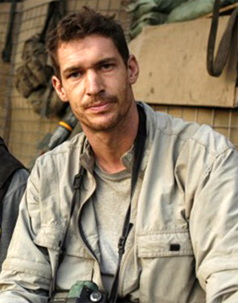 It’s just after midnight on Wednesday and I really should be in bed. My day job with the U.S. Marshals Service demands a 4:30 am wake-up call followed by a 1.5 hour train commute. Any responsible adult would have hit the sack hours ago, but what the hell…I’ve already accepted the fact that tomorrow I probably won’t be worth a damn anyway. Why am I still awake? I just finished watching what may be the best short film that I have ever seen.
It’s just after midnight on Wednesday and I really should be in bed. My day job with the U.S. Marshals Service demands a 4:30 am wake-up call followed by a 1.5 hour train commute. Any responsible adult would have hit the sack hours ago, but what the hell…I’ve already accepted the fact that tomorrow I probably won’t be worth a damn anyway. Why am I still awake? I just finished watching what may be the best short film that I have ever seen.
It’s called Restrepo and it tells the incredible life and death story of a forward-deployed U.S. platoon in Afghanistan, operating in the Korengal Valley. It’s raw, visceral, and makes you proud to be from a country where boys like this are raised. It was released by National Geographic Entertainment, nominated for an Oscar (Best Documentary) and won the 2010 Sundance Film Festival Grand Jury Prize. Film critic Peter Travers outlined this remarkable movie's plotline for his review in Rolling Stone Magazine:
Here's a documentary that embeds you deep into the war in Afghanistan. Filmmakers Tim Hetherington and Sebastian Junger follow a platoon of U.S. soldiers, the Second Platoon, Battle Company, 173rd Airborne Brigade, during their 14-month deployment to the Korengal Valley. The troops are shaken when their beloved medic, Juan "Doc" Restrepo, is killed in action. That’s when Capt. Dan Kearney pulls out all the stops to allay fears even in the Taliban war zone. Naming their base after Restrepo, these soldiers are seen dealing with death on a daily basis. The filmmakers offer no commentary. We watch. And what we see is explosive, deeply moving and impossible to shake.
As a documentary producer, I am ashamed to say that I only learned of this film today after reading a report that its director/co-producer was killed while covering the fighting in Misratah, Libya. Another photojournalist was killed in the attack and several others on their crew were badly wounded. This seems to be the same sad story that we have heard all too often in recent years…some son of a bitch in a towel with an RPG pops out of a hole and takes a potshot at the good guys. I guess these insurgents and rebels think that the media makes just as good a target as soldiers do. It speaks to their cowardice as attacks on the press have ramped up all over that part of the world. I guess if you can’t hit the guys with guns, aim at the guys with cameras. Bastards.
The brilliant mind behind this film is, or was, Tim Hetherington, a highly respected British journalist and filmmaker. He was an experienced, imbedded-correspondent with an amazing talent for stripping away all the political bullshit to reveal the tragic simplicity of war. I read several interviews with him this evening and one statement in particular jumped out at me. He said, “I’ve come to realize the war machine is, in fact, very human. Take a group of young men, train them together, put them on the side of a mountain and they will kill and be killed for each other.” That sums it up.
As someone living in VA and working in DC, I know soldiers that were deployed to Afghanistan, as well as some contractors that are there now. THESE guys are the real heroes. They volunteer to do the most dangerous jobs – in the most dangerous places. And they do it to protect us and improve the lives of uncivilized people who hate them. The debt we owe them can never be paid in full.
Afghanistan is a mess. It is an undeveloped bastion of ‘suck’ on a good day, so I can’t even begin to imagine what daily firefights and mortar attacks does for the place. Yet here we have a team of documentary filmmakers, right in the thick of it, getting incredible footage while ducking bullets and tracers. The result is an intimate portrait, plucked from the chaos of combat that cannot be duplicated any other way.
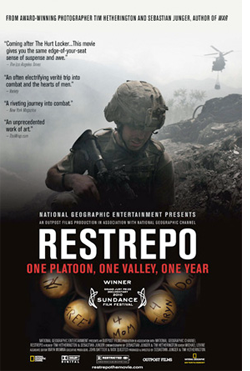 Unlike most films today, Restrepo doesn’t have any fancy graphics or special effects. The instrumental song that plays the audience in and out of the film was performed live by a soldier with a dirty acoustic guitar. Some of the footage is gritty and blurry and so freaking real you get a knot in the pit of your stomach as you watch it. The stress level that these soldiers experienced is shared beyond the screen as you too find yourself anticipating the danger that lies around the bend. Several of the troops are shot and killed during the film, reinforcing the fact that this is reality-TV for real.
Unlike most films today, Restrepo doesn’t have any fancy graphics or special effects. The instrumental song that plays the audience in and out of the film was performed live by a soldier with a dirty acoustic guitar. Some of the footage is gritty and blurry and so freaking real you get a knot in the pit of your stomach as you watch it. The stress level that these soldiers experienced is shared beyond the screen as you too find yourself anticipating the danger that lies around the bend. Several of the troops are shot and killed during the film, reinforcing the fact that this is reality-TV for real.
I never met Mr. Hetherington, nor was I aware of his contributions to the world until today. Unfortunately it is only after his untimely death that I am now discovering an amazing body of work from print and television - to film and photo.
Our documentary projects at Right Stripe Media are historic and take place on Civil War battlefields and Wild West sites hundreds of years after the fighting ended. If we want to show the carnage, we recreate battles and gunfights with re-enactors and pyrotechnics. The only danger we face on one of our shoots is sunburn or maybe eye strain from spending too much time at the computer. So it’s a very sincere gesture when I say that I want to tip my hat to all of these battlefield filmmakers, especially Tim Hetherington for having the vision, and the balls, to create movies like Restrepo.
Real war-journalists, the “Hetheringtons” of the world, risk life and limb to visually preserve and present history as it unfolds. Our production group’s mantra is that we create living history. Tim and his comrades capture it. He will be missed by many, now including me. And although I may never produce a documentary with the soul of Restrepo, I am inspired to try, now more than ever.
ADDED 4/21: Our friend Jared Frederick over at History Matters had the pleasure of meeting and speaking with Tim Hetherington a few months ago. He posted a wonderful blog piece on February 22nd detailing the experience.
Homeward Bound
My posts will be far and few over the next week as I prepare for my upcoming lecture and screening at the CarnegieCarnegie Library and Music Hall’s 6th Annual Civil War Weekend. You may recall that we held our ‘northern’ premiere of “The Angel of Marye’s Heights” documentary at this venue back in November. It was an absolute thrill for me as Pittsburgh PA is my hometown and I was able to share the experience with plenty of friends and family. This event looks to be even better (see schedule) and I hope to become a recurring participant. On Saturday April 30th, I will be giving a lecture titled “Gallant Boys of the 123rd,” which presents the experiences of the PA Volunteers at the Battle of Fredericksburg. That will be followed by a screening of “The Angel” w/ a producer Q&A. Once that is finished I get to do it all over again. In addition to our traveling exhibit that features a kiosk, props and handouts, I will be joined by Pittsburgh author Scott Lang who wrote The Forgotten Charge: The 123rd Pennsylvania at Marye's Heights, Fredericksburg, Virginia. Scott has a wonderful collection of 123rd relics that he will be displaying at an adjacent table. I will have copies of “The Angel” DVD for sale ($12) as well as Will White’s soundtrack CD ($10). I’ll also have photos and video to share upon my return. I will be hosting 2 film screenings and a book signing at the Manassas Museum on May 15th (details to come).
Continuing with our recurring theme on the myths of the Founding Fathers…
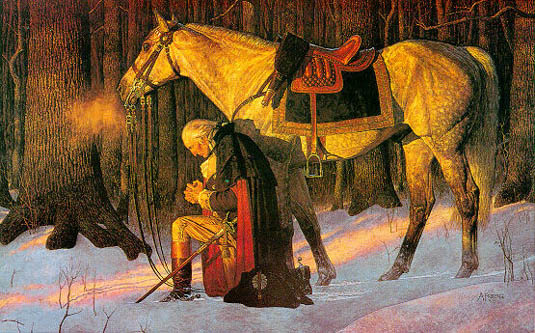
You may be familiar with the painting above titled “The Prayer at Valley Forge.” This controversial image was painted by artist Arnold Friberg to celebrate our country's Bicentennial in 1976. It is one of several notable artworks depicting General George Washington in the act of prayer while at Valley Forge. In the Congressional Prayer Room at the Capitol there is a stained-glass window also depicting the general on his knees, praying in the snow at the same location. Similar images appeared on a 2-cent stamp in 1928 commemorating the 150th anniversary of the Valley Forge encampment, and on the 13-cent Christmas stamp in 1977. Although it is very likely that Washington prayed while on campaign, this particular (and repetitive) depiction of him (at Valley Forge) stems from a highly-contested story which is believed and refuted by many.
Even a casual Google search on this event will reveal all kinds of amateur/unsanctioned web-pages where religious organizations or individuals have assembled various incarnations of this event. Some even include quotes, which were apparently “re-discovered” in the 20th-century. These fallacies appear to fulfill a need to validate that America was founded as a Christian nation. One page even states that: “His ‘Prayer at Valley Forge’ was a well known fact until the latter half of the 20th century, when the United States, in the process of replacing Christianity with Secular Humanism, allowed itself to believe that the prayer was merely sentimental legend.” Of course there is no source to support this claim.
It is the need to ‘prove’ or ‘disprove’ this event that fascinates me. For a more scholarly (and perhaps objective) interpretation of this event, I looked to renowned Washington historian Edward G. Lengel. Professor Lengel is the editor in chief of the prestigious Papers of George Washington project at the University of Virginia. He has also written two excellent books on the man. These include Inventing George Washington: America's Founder, in Myth and Memory and my personal favorite, General George Washington: A Military Life. He is without an agenda and according to him; there is less to the story.
I’m not the only one who considers Dr. Lengel an expert. In an article written for the Boston Globe titled “The many myths of George Washington,” contributing writer Michael Kenney challenges the genesis of this depiction of a praying patriot by quoting the author. He writes:
Despite the depictions [of Washington praying at Valley Forge], it is a story with “dubious origins,’’ writes Edward G. Lengel in “Inventing George Washington,’’ his account of the myths and legends that sprang up to breathe life into a symbolic figure. Like the kneeling-in-the-snow tale, the cherry-tree yarn first appeared in “Parson’’ Mason Weems’s biography published in 1800 — a temporal immediacy that did not, however, turn the anecdotes into facts. Weems, Lengel explains, was “lazy’’ about research and facts, allowing his imitators to produce “an increasingly outrageous array of myth, legend, and outright fraud in the name of recovering Washington’s humanity.’’ Lengel’s claims intentionally counter the oft-misquoted account that “supports” this moment of Washington knelt in prayer. It was apparently recorded in the “Diary and Remembrances” of Reverend Nathaniel Randolph Snowden who recalled:
…"Do you see that woods, & that plain?" It was about a quarter of a mile off from the place we were riding, as it happened. "There," said he, "laid the army of Washington. It was a most distressing time of ye war, and all were for giving up the Ship but that great and good man. In that woods pointing to a close in view, I heard a plaintive sound as, of a man at prayer. I tied my horse to a sapling & went quietly into the woods & to my astonishment I saw the great George Washington on his knees alone, with his sword on one side and his cocked hat on the other. He was at Prayer to the God of the Armies, beseeching to interpose with his Divine aid, as it was ye Crisis, & the cause of the country, of humanity & of the world. Such a prayer I never heard from the lips of man. I left him alone praying. I went home & told my wife, I saw a sight and heard today what I never saw or heard before, and just related to her what I had seen & heard & observed. We never thought a man c'd be a soldier & a Christian, but if there is one in the world, it is Washington. She also was astonished. We thought it was the cause of God, & America could prevail." As wonderful as that sounds, it is obviously written with a flair for the dramatic. Even as far back as 1945, Washington curators and historians have questioned the validity of this story. In an article written for the Valley Forge Historical Society’s publication The Picket Post titled “Prayer of Valley Forge May Be Legend or Tradition or a Fact, Yet It Remains Symbol of Faith” author Gilbert Starling Jones states:
Few incidents in the life and actions of Washington, while he was Commander-in-Chief of the armed forces battling for The Independence of the American Colonies have been more controversial or more often related than the "Prayer of Valley Forge." Did he, or did he not, pray at the Winter Encampment is quite as familiar to readers of historical tomes touching the American Revolution as "to be or not to be" is to the average man who may or may not know further about the Bard of Avon. No attempt is made, presently, by this compiler to establish documentary proof that Washington was seen at Valley Forge in supplication upon the Divine Will in the need of Almighty direction. The purpose, more especially, is to direct the readers' thoughts into a channel whereby to essay the relations of an episode, be it traditional or fact, that may furnish a key to the inner depths of the character of the great and lonely man at Valley Forge — a character so needed in today's world. It appears that even the society charged with the preservation and presentation of Valley Forge history openly admitted the questionable accuracy of the story. Since then this particular image of Washington has grown to become as much a cherished memory as a form of propaganda. This is no doubt due to the governmental-endorsement implied by the stained glass and stamps – and the convenience it levies to religious groups. In addition to print and paintings a bogus guidebook was published that directed Valley Forge tourists to the: “exact spot upon which the General kneeled in prayer.” This is perhaps the falsest claim of all.
The question in my mind is not if George Washington did or didn’t pray at Valley Forge as presented in the above descriptions. The questions are why is this particular event so significant? Why this moment – at this location? And why did it become such a contested image?
Historically, I’m with Dr. Lengel. I don’t necessarily believe that this painting depicts an actual event. I also don’t fancy the fact that religious organizations claim absolute validity over it in support of their political agenda. I do however, believe what this image represents. Valley Forge was one of the lowest points for the Continental Army. It is during the most trying of times that our faith most often prevails. Accurate or not, General Washington sets an example we all could follow.
Let’s have a little fun with today’s post.
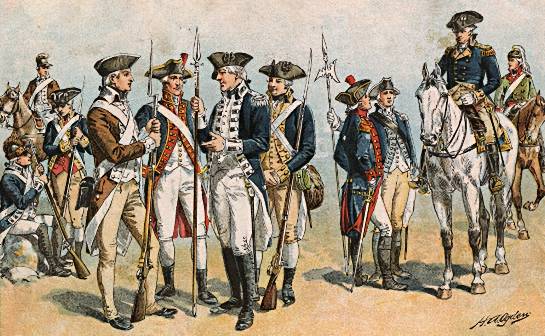
Two of our most popular movie stars from today’s big screen have ancestors who fought in the American Revolution.
Brad Pitt’s sixth great-grandfather, Abraham Hammer, who was a Quaker, was told to leave his Quaker community in 1768 for “warlike preparations.” He was among the many who petitioned North Carolina for unjust taxation. Their petition later started the Battle of Alamance, which is considered to be one of the first battles of the American Revolutionary War. (Source: Access Hollywood)
According to the NC Historic Sites webpage on the Battle of Alamance:
Here in 1771, an armed rebellion of backcountry farmers called Regulators battled with royal governor William Tryon's militia. The spark for this conflict was growing resentment in the Carolina colony against the taxes, dishonest sheriffs, and illegal fees imposed by the British Crown. In response, the Regulators were formed and began to fight back. Though the rebellion was crushed, a few years later their tactics became a model for the colonists fighting the British in the American Revolutionary War.
The battle began on May 16 after the Regulators rejected Tryon's suggestion that they disperse peacefully. Lacking leadership, organization, and adequate arms and ammunition, the Regulators were no match for Tryon's militia. Many Regulators fled, leaving their bolder comrades to fight on. …The rebellion of the Regulators was crushed. Nine members of the king's militia were killed and 61 wounded. The Regulator losses were much greater, though exact numbers are unknown. Tryon took 15 prisoners; seven were hung later. Many Regulators moved on to other frontier areas beyond North Carolina. Those who stayed were offered pardons by the governor in exchange for pledging an oath of allegiance to the royal government.
Johnny Depp’s fifth great-grandfather William Depp served in the American Revolution. He fought in the March 1781 Battle of Guilford Courthouse in North Carolina. He enlisted in the Virginia state militia three times. (Source: Access Hollywood)
According to the National Park Service webpage on the Battle of Guilford Courthouse:
On March 15, 1781. the largest, most hotly-contested battle of the Revolutionary War's Southern Campaign was fought at the small North Carolina backcounty hamlet of Guilford Courthouse. Major General Nathanael Greene, defending the ground at Guilford Courthouse with an army of almost 4,500 American militia and Continentals, was tactically defeated by a smaller British army of about 1,900 veteran regulars and German allies commanded by Lord Charles Cornwallis. After 2 1/2 hours of intense and often brutal fighting, Cornwallis forced his opponent to withdraw from the field. Greene's retreat preserved the strength of his army, but Cornwallis's frail victory was won at the cost of over 25% of his army.
Guilford Courthouse proved to be the highwater mark of British military operations in the Revolutionary War. Weakened in his campaign against Greene, Cornwallis abandoned the Carolinas hoping for success in Virginia. At Yorktown, seven months after his victory at Guilford Courthouse, Lord Cornwallis would surrender to the combined American and French forces under General George Washington.
In reference to yesterday’s post...
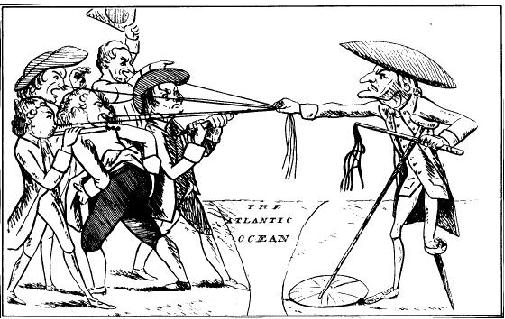
Political Cartoon: “Poor Old England endeavoring to reclaim his wicked American children”
Here is an example of the experiences faced by Loyalists living in the colonies. This letter describes the hardship faced by an entire family in Tryon County NY who remained loyal to the crown.
RETRANSCRIPTION D’UNE LETTRE DE WILLIAM KENNEDY AU COLONEL ABRAHAM CYLER
Mountriall yr 6th November 1782
Sr
Those few lines are to let you know that I am very glad that you or so good a Kings subject should be put in head of the Loyalists whom some are fellow sufferers & some not. It is a thing now at present to be looked into who is loyal & who not and what they have suffered for their loyalty and what not. For my part I heard of your coming to this town by my not being acquainted with you in person made me not go to see you though. I was well acquainted with what you suffered for your loyalty.....and as for my part when you come to enquire into my character you will find that I have suffered my part from the beginning of the war for when you were confined in Albany and elsewhere I was confined in Johnstown so long that I had one pound and fifteen shillings to pay for the water I used. I got out after a while and In sometime after there where a party of Indians went from here to sacondagy comanded by Capt. Flaton who is now here. The rebels made an atempt to prove that I aided assisted & provisioned them. I was obliged to fly from my house the 5th June and kept myself secreted till the last Tuesday in 7ber when by the advice of my best friends I stood Tryall of my life in Johnstown where they had not sufficient prooff against me. I got clear. The year following there was a party of Indians broke out at Mayfield where they killed one Dunam & his son. The rebels aledged against me that I was the cause of it and that the said Indians come from Sr John Johnson to me with leters and to cary news or leters back from me how the country stood affected upon which there were beter than two hundred rebels come to bury the dead and took me prisoner and after to setle their minds they hung me up till they thought I was dead and then they cut me down and my wife being there she brought me back to my house on her back which was beter than a half a mile. In about a month after when they found I was alive and likely to get well they came and tore all the house to pieces and robed me of all the cloathes that was in the house which among the the rest they had thirteen lining shelts (sheets?). So next morning my wife and six small children were naked except what they lay in then I had a good many head of chatle and they warned me from my farm 7 miles where I remained under suspition & a bad character with them till they took & tryed one Harmonious Flock a Low Dutch man who is here now setler in Sr. Johnn Regt. & I for Life at the house of Margret Wemple at the Mohawk River where we were cleared of the fact yet very much suspected then. I remained so untill last October that is thirteen months ago when some Evill minded person who wanted to cary favour with the rebels informed them that I had sent upwards of a hundred men to Canada for the use of Sr John Johnson and likewise had leters backward & forward and that I was so crafty in it, it could not be proved against me yet the same person will doubtless appear as Loyalist upon which Colonell Merinus Willet sent a Gaurd and took me prisoner to fort plain or Conajohary where he erected a galows to hung me he could not get sufficient evidence against me though still he kept me prisoner the mean while Major Ross and Capt. Butler broke out with a party and burned severall houses at Warinsbush and fought the Rebels at Johnstown After they retracted I was sent prisoner to Albany where I remained prisner for near five months in Company of Mr Shepherd Bllor Chambers Swain and several others where we were not to get one penyworth of subsistance at the Country’s cost. Then Doctor Stringer & frind a Fisher & their other Confederates sent word up where I lived that I certainly would be hangd. Upon which Warins Bush peopel to make up for their loss took my chatles horses sadle bridle cloathing houshowld stuff and even my wife and childrens shirts shoes and stockings. Afterwards inspight of Stringer & his club Judge Morris got out Shepherd Bloor and I at one day and when I got out I entended to take the law of them for my efects but they soon put and end to that. They come with 48 men and warned me and several others at a Quarter of an hours warning to quit the Country upon which my wife was oblidged to leave her house with her six children and she bearfootd with her youngest child on her back when the snow was upwards of two foot deep.....and they would not allow her to take a loaf of bread out of the house You may very well judge Sr that I could not have much money neighther had I cloathes yet I was oblidged to find enough to fetch me and my wife and six children into Mountriall at my owen expenses I realy did expect and so did every gentleman and every poor man that was a good Subject between Canderhook & the German Flats that if ever It would be my turn to come to Canada I would surely be well dealt by. Yet I canot say that I receved a peny favour yet from ever a man in America and as I have no trade nor no money to begin with this is a hard place to live in I canot but be very thankfull to both Major Jesop & Mr Ducoine for their kindness to me yet the Bigest Rebel comes out of the country is beter used than the best subject you but enquire of Mr Stuarts Revce and of Mr Sanders Cambell and in short of all others that is called Loyalists wheather all and more that I write conserning Sufrence is not true which after due consideration I hope you will assist me in Justice what Lyes in yr power as I am Sr. Yr. most Humble and most obedt. Servant. Wm. Kennedy.
 It’s just after midnight on Wednesday and I really should be in bed. My day job with the U.S. Marshals Service demands a 4:30 am wake-up call followed by a 1.5 hour train commute. Any responsible adult would have hit the sack hours ago, but what the hell…I’ve already accepted the fact that tomorrow I probably won’t be worth a damn anyway. Why am I still awake? I just finished watching what may be the best short film that I have ever seen.
It’s just after midnight on Wednesday and I really should be in bed. My day job with the U.S. Marshals Service demands a 4:30 am wake-up call followed by a 1.5 hour train commute. Any responsible adult would have hit the sack hours ago, but what the hell…I’ve already accepted the fact that tomorrow I probably won’t be worth a damn anyway. Why am I still awake? I just finished watching what may be the best short film that I have ever seen. Unlike most films today, Restrepo doesn’t have any fancy graphics or special effects. The instrumental song that plays the audience in and out of the film was performed live by a soldier with a dirty acoustic guitar. Some of the footage is gritty and blurry and so freaking real you get a knot in the pit of your stomach as you watch it. The stress level that these soldiers experienced is shared beyond the screen as you too find yourself anticipating the danger that lies around the bend. Several of the troops are shot and killed during the film, reinforcing the fact that this is reality-TV for real.
Unlike most films today, Restrepo doesn’t have any fancy graphics or special effects. The instrumental song that plays the audience in and out of the film was performed live by a soldier with a dirty acoustic guitar. Some of the footage is gritty and blurry and so freaking real you get a knot in the pit of your stomach as you watch it. The stress level that these soldiers experienced is shared beyond the screen as you too find yourself anticipating the danger that lies around the bend. Several of the troops are shot and killed during the film, reinforcing the fact that this is reality-TV for real. 







